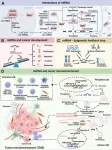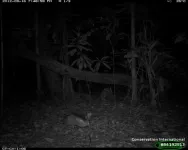(Press-News.org) New research published in the Journal of Stroke and Cerebrovascular Diseases confirms that strokes thought to happen in older adults are possible in the younger (defined as 18-50 years old) population. Large Vessel Occlusion Acute ischemic Strokes (LVO-AIS) are considered to be the most debilitating strokes which occur due to blockage of large cerebral arteries usually from blood clots or plaque build up. LVO-AIS is typically thought to occur in older adults given that older individuals are known to have risk factors for large vessel occlusions. However, new research confirms that the younger population can have risk factors for these types of large-vessel occlusion strokes and have LVO-AIS at similar rates to older adults. Getting tested and seeing a primary care provider regularly are essential for stroke risk prevention.
Effect of Stroke Etiology on Treatment-Related Outcomes in Young Adults with Large Vessel Occlusion: Results from a Retrospective Cohort Study - ScienceDirect
The data shows that young adults suffer from large-vessel occlusion strokes just like older adults, and the majority have good outcomes if they arrive in a timely fasion and are treated with IV thrombolysis and thrombectomy.
The study looked at the young adult stroke population, while most studies have looked at older adults when looking back at patient populations. Cleveland Clinic looked at over 1,200 young adult patients from 2017 to 2021 in Ohio. Of that group, nearly 20% had large-vessel occlusion ischemic strokes, very similar strokes to older adults.
Half of the patients received no intervention, while 25% of those got no acute intervention because they arrived at the hospital too late. Had they arrived earlier, they could have been eligible for IV thrombolysis and possibly both IV thrombolysis and thrombectomy.
"This research helps us raise awareness about recognizing stroke symptoms in young adults early and that getting prompt treatment is paramount to achieve good outcomes,” said Abbas Kharal, M.D., a cerebrovascular neurologist with Cleveland Clinic's Cerebrovascular Center. “Further study is needed to identify barriers as to why young adults are delayed in seeking treatment for stroke, especially when they can have better outcomes than older adults if treated promptly. Many people still think of stroke as an event happening in the older population, but that is not what we are seeing in our practices. The younger population faces similar risk factors which need to be addressed through routine clinical check ups."
Dr. Kharal said that young adult patients in our study experienced large-vessel occlusion strokes from blood clots or plaque formation, factors that are typically thought of in older adults, in addition to other causes including arterial diseases and cardiac issues. Ongoing studies at Cleveland Clinic are looking at more detailed causes of large vessel occlusion ischemic stroke in young adults. We must urge young adults to recognize stroke symptoms and seek immediate medical attention when faced with new neurological deficits. Moreover, emphasizing the importance of stroke risk factor screening and control of these risk factors can help reduce stroke risk in young adults.
END
New research confirms that young adults can also have large vessel occlusion strokes thought to happen in older adults, given the rise of stroke risk factors in younger adults
2024-10-16
ELSE PRESS RELEASES FROM THIS DATE:
Grasslands live in the climate change fast lane
2024-10-16
Although all ecosystems are affected by a changing climate, the impacts can take a while to appear. Changes in forest biodiversity, for example, are known to lag behind changes in a habitat's temperature and precipitation.
Grasslands, on the other hand, are responding to climate change almost in real time, according to new research by the University of Michigan. Put another way, forests accumulate climate debt while grasslands are paying as they go, said the study's lead authors, Kai Zhu and Yiluan Song.
"Climate change does have consequences for our ecosystems. It's going to come sooner or later," said Song, a postdoctoral fellow at the ...
Mount Sinai Doctors to present at ID Week 2024
2024-10-16
Experts in infection prevention and control at the Mount Sinai Health will present new research and insights at ID Week, the joint annual meeting of the Infectious Diseases Society of America, the Society for Healthcare Epidemiology of America, the HIV Medicine Association, the Pediatric Infectious Diseases Society, and the Society of Infectious Diseases Pharmacists in Los Angeles from October 16-19.
Mount Sinai doctors and researchers are also available for comment on breaking health news including the flu, COVID variants, HIV/AIDS, mpox, West Nile virus, measles, and fall vaccinations.
PRESENTATIONS and POSTER SESSIONS
*All abstracts and presentations ...
Rewriting the future: New molecules reversibly change with light and heat
2024-10-16
In this age of cloud storage, few people are backing up data on CD-RWs. The technology to rewrite data on compact discs was made possible by phase-change materials altered by the light and heat of lasers, though this had a limit of 1,000 rewrites. Today, scientists investigating photoswitching molecules, which change their properties when irradiated, have been finding possible applications for these materials, ranging from photopharmacology to data storage.
Osaka Metropolitan University Graduate School of Engineering student Shota Hamatani, Dr. Daichi Kitagawa, a lecturer, and Professor Seiya Kobatake synthesized aza-diarylethenes, which have nitrogen in place of carbon in a molecular structure ...
New breakthrough in quantum computing development, hybrid quantum error correction technology
2024-10-16
A major challenge in realizing quantum computers is the development of 'quantum error correction' technology. This technology offers a solution for addressing errors that occur in the qubit, the basic unit of quantum computation, and prevents them from being amplified during the computation. Without quantum error correction, it would be impossible for quantum computers to outperform classical counterparts, and thus efforts to advance this technology are ongoing worldwide.
Dr. Seung-Woo Lee's research team at the Korea ...
Unlocking the future: Information processing at the speed of light
2024-10-16
The integration of photonics into quantum computing has profound implications across various domains. As the demand for faster and more secure computational capabilities intensifies, photonic quantum computing emerges as a pivotal force, with the photonics market projected to reach USD 837.8 billion by 2025.
Harnessing the unique properties of light, photonic quantum computing revolutionizes data processing by encoding information in photons, offering unprecedented speed and efficiency for solving complex problems that traditional methods struggle to address. Photonic quantum computers can ...
A new chapter in cancer treatment: Innovative strategies and technologies of miRNA
2024-10-16
This study is led by Dr. Shiwei Duan (Department of Clinical Medicine, School of Medicine, Hangzhou City University, Hangzhou, Zhejiang, China). His team analyzed literature on miRNA, summarizing the close relationship between these small molecules and cancer. miRNA is a type of non-coding RNA that does not encode proteins, but can target more than 60% of human protein-coding genes. They play crucial roles in cell growth, differentiation, development, and apoptosis, and their dysfunction is closely linked to numerous diseases. Almost all known cancer cells have the ability to control gene expression using miRNAs, making the impact of miRNAs particularly significant ...
Silicon metasurfaces unlock broad-spectrum infrared imaging.
2024-10-16
Infrared imaging technology is crucial for advancing our understanding of the world, from exploring biological specimens to inspecting complex materials and detecting hidden patterns in physical systems. Infrared light can penetrate fog and smoke, making it invaluable for search and rescue, firefighting, and sensitive operations. Additionally, infrared imaging can enable visualising the heat emitted by objects, making it a powerful tool for night vision and security applications. While infrared cameras are valuable tools for enhanced ...
New research suggests: To get patients to accept medical AI, remind them of human biases
2024-10-16
While people are growing more accustomed to AI-driven personal assistants, customer service chatbots and even financial advisors, when it comes to healthcare, most still want it with a human touch.
Given that receiving healthcare is a deeply personal experience, it’s understandable that patients prefer it to come from, well, a person. But with AI’s vast potential to increase the quality, efficacy and efficiency of medicine, a push toward greater acceptance of artificial intelligence-driven medicine could unlock benefits ...
OIST and Partisia sign MOU to advance the research and development of multi-party computation and privacy enhancing technologies
2024-10-16
The Okinawa Institute of Science and Technology (OIST) and the Danish software company Partisia have signed a Memorandum of Understanding (MOU) to strengthen their research ties.
The primary objective of this collaboration is to advance research in Multi-Party Computation (MPC), focusing on developing innovative Privacy-Enhancing Technology solutions. By leveraging their combined knowledge and expertise, OIST and Partisia aim to deliver a global perspective on secure computation, quantum-safe cryptography, and cyber security.
OIST will contribute to the collaboration with its in-house expertise and ...
Beware of the full moon: Tropical forest mammals shy away from the moonlight
2024-10-16
A recent study using automatic wildlife cameras across three continents has shed light on how the moon's phases affect the behaviour of tropical forest mammals. Half of the species studied altered their activity levels or timing, or both, in response to the full moon. The findings suggest that even in some of the darkest places on earth - the floors of tropical forests - the moon's phases can influence animal behaviour. This impact could be even more pronounced in degraded and fragmented forests.
“Imagine playing hide-and-seek in a dark room, and then somebody lights ...





